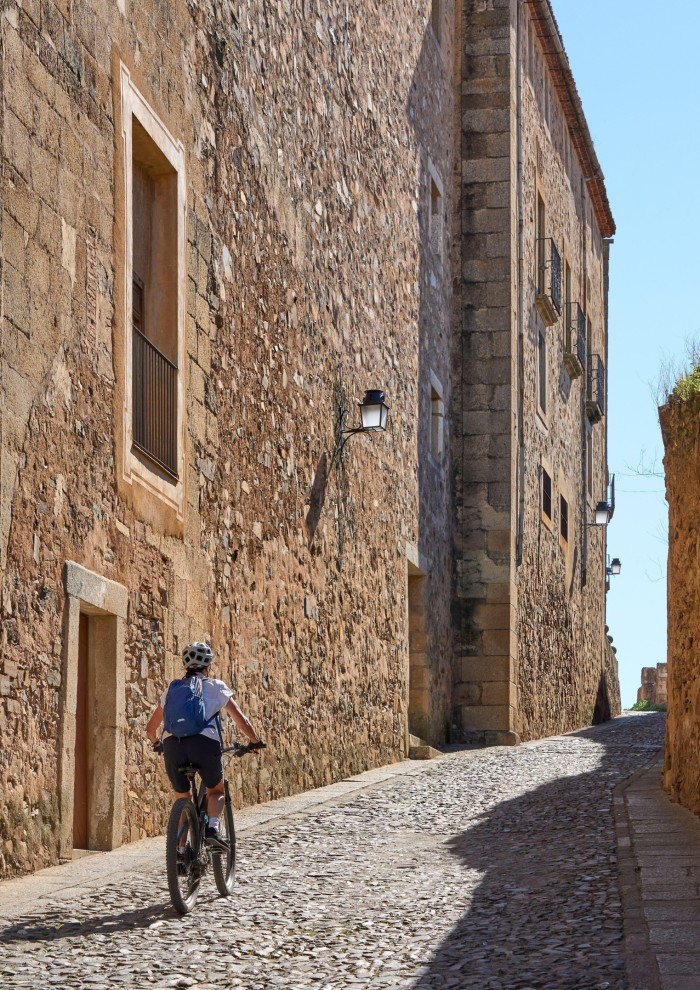exploring Spain’s fabulous historic hotels by bike

For a long time, the Palace of Oropesa cut a forlorn silhouette amid the dusty horizons of La Mancha. By the start of the 20th century, its last aristocratic owners had moved out and rot had set in: the medieval stones crumbled and the building was soon bereft of its former majesty. The palace variously served as a school, an abattoir, a theatre, a police station and a storehouse for acorns gathered in the mountains. Its courtyard became a bullring.
Then along came Platón Páramo: a local antiques collector with a bushy white beard, an eye for interior design and a plan. He suggested that, with government support, the palace’s warren of corridors and state rooms might be repurposed as a hotel — a rare enterprise in this Spanish hinterland. Its dishevelment could be remedied: history would be part of the new hostelry’s appeal.
The establishment opened in 1930 and had a modest start. Water came from a well, vegetables from gardens beneath the battlements, the furniture (in part) from Paramo’s own collection. The building’s caretaker was, in its first days, a child.
Sometimes as many as four days would pass without a guest arriving, but a precedent had been set: the palace at Oropesa was the first historic building to be converted into a parador, part of a newly formed, government-owned hotel chain designed to promote the country’s fledgling tourism industry and protect national heritage. It provided a template still being followed across Spain a century on. Almost a hundred ancient buildings are now paradors — monasteries, castles, mansions and other venerable structures given a second life as unique hotels (and usually with reasonable rates that belie their charm and singularity).

Tourism has grown into a multibillion-euro industry in Spain; this summer saw protests against its effects in Mallorca, while authorities in Barcelona put forward plans to curtail short-term rentals on Airbnb. And yet visiting Oropesa — where those hospitality pioneers began — you remain far away from the well-trammelled circuit, and far closer to the ghosts of this country’s past. Two hours’ train ride west of Madrid, the palace appears on a little hillock, rising on the edge of the plains where Cervantes placed the adventures of those two companions on horseback.

Arriving at the Parador de Oropesa today has the magic common to many other paradors — a kind of trespassory thrill; a disbelief that this is somewhere ordinary layfolk can stay. A gatehouse led me to a courtyard shaded by Moorish towers. An oil painting of a naval battle hung in a hall full of heraldry.
You could stand on wrought iron balconies, and watch swifts swooping out of invisible nooks in the masonry. You could also read displays on the Álvarez de Toledo family who were resident here: one of whom became the Viceroy of Peru and condemned the last ruler of the Neo-Incan state to death. Those displays said less about that decade following the hotel’s opening, and the day when Republicans assembled the local bourgeoisie in the courtyard of the parador, intending to set the bulls among them. Nationalists later stormed the building. After restoration, the parador reopened in 1942.
To my mind, most interesting were the guest rooms, accessed by a weighty key rather than a plastic card, shoehorned in amid medieval walls. Here you might imagine the unrecorded wayfarers who passed through the same room as you — mercenaries, monks, merchants — finding respite on journeys across the parched miles of the peninsula.


I too was heading off on a journey, exploring a little archipelago of paradors on a bike ride stretching west out of La Mancha and into Extremadura. Arranged by Macs Adventure, a tour operator specialising in self-guided hiking and biking, the full itinerary lasts a week, clocking up five paradors en route from Oropesa to Cáceres, and covering between 45km and 68km per day, with luggage transferred by car.
I was tackling a shorter version, picking up a bike by the parador gate and my route notes via an app, then visiting three paradors and another historic lodge. Over three days I pedalled some 200km; bumped across the cobbles of about 10 villages, three times hit the brakes to swim in mountain rivers and once disturbed an eagle which took flight on a silent country lane metres ahead of me. Admittedly I was travelling midweek in October, taking a dawdling route through the back-country. But of the 85mn annual tourist arrivals in Spain, outside the paradors I saw less than three dozen.
I left Oropesa early the next morning, and cycled north-west across plains crusty and cracked after a summer of merciless heat. All was still, apart from a barking dog that chased my bicycle at a roadside farm, and a soft wind that swayed the silvery branches of olives. The villages too were still, their cafés opening late the morning after an Atletico-Real derby: by mid-morning the metal shutters were still down and hot to touch.
Ahead of me, the cool blue mass of the Sierra de Gredos arose from the dust — one of the ranges that run in long, diagonal bands across the Meseta Central of Spain. Near the banks of the Río Tiétar, I passed an estate with a whitewashed gate beneath an arch, flanked by two crude copies of Botticelli’s “The Birth of Venus” painted on ceramic tiles. Above the arch, under a weathervane, was written the name: “El Paraiso”. A few miles later, a more prosaic road sign marked the border of Castile-La Mancha and Extremadura.

This is a region of many forbidding names — La Mancha possibly derives from the Arabic al-mansha — meaning the “waterless land”, while Extremadura, by some accounts denotes a far off, harsh territory. Entering the latter, however, the country softened in character. Baked plains rose into the breezy foothills of the Sierra de Gredos, forested with pine, oak and juniper, and citrus groves heavy with ripe fruit. Villages gurgled with fountains fed from the slopes above, while signs pointed to “Gargantas” (gorges) — where waterfalls tumbled through ravines, regaining their strength with autumn rains.
Some had been dammed to form natural swimming pools: hundreds of miles from the sea, you enter an inland riviera where capital dwellers come to cool down on summer weekends. I swam alone among little black fish under the medieval span of Puente de Cuartos, overwhelmingly pleased to be here rather than hunting for a deckchair on the Andalusian coast.
Though this little paradise was never a secret. Of the many guests who lodged at the palace of Oropesa, none was more distinguished than Charles V — King of Spain, Archduke of Austria, Holy Roman Emperor and, in the 16th century, the most powerful man in the world. His dominion stretched across Europe — from the Low Countries to Sicily, from the Alps to Transylvania — and also to north Africa and the New World. His was the first empire on which it was said that “the sun never set” and accordingly his was a life full of travel.



He spent a quarter of his reign on the move, contending with the Reformation in the west and Ottoman armies in the east. By his fifties he had aged prematurely, grown weary from ruling such a vast empire, and suffered gout. He abdicated his titles in tears, split his empire in two and resolved to undertake one final voyage — choosing the Sierra de Gredos above all others in his realm as the place to spend the twilight of his life.
He gave orders for a palace to be built adjoining a monastery in the mountains at Yuste and, while it was being finished, lodged for a winter at the Castle of Jarandilla — today the Parador of Jarandilla, and the next stop on my ride. Another outpost of the counts at Oropesa, it cut a slightly more muscular, military profile than their home to the south-east: stout towers bordered by orange trees, with clumps of bamboo sprouting in a moat. Signs warned guests to be wary of debris falling from the stork’s nests on the roof. A copy of Titian’s portrait of Charles V hung at the end of a long corridor, a reminder of the November of 1556 when the king arrived around the time the first snows fell.

The hotel followed the same parador formula as at Oropesa and elsewhere — the guestrooms resistant to the fads of Nespresso machines or rain showers, instead filled with heavy polished furniture, and a table upon which biscuits were placed in the late afternoon. I fell asleep to the sounds of palm fronds brushing against the battlements, and the next day cycled the same journey that Charles V undertook in his sedan chair, up through the forests towards Yuste.
The road zigzagged through forests filled with the sharp, resinous scent of pine. The monastery of Yuste emerged behind a row of eucalyptuses: its gatehouse painted with a diamond motif, its courtyards fragrant with dewy jasmine. Upon his death, Charles V’s son Philip II ordered his father’s quarters be preserved as they were: meaning visitors get a window into the last days of this all-powerful king.



I followed a ramp built for the ailing king to reach a loggia with a view of flowerbeds and distant sierras. Most touching was the royal chamber: small and shadowy, the bed placed at an angle so the king could have a sightline from his pillow to the altar of the adjoining chapel once he became too weak to rise. He died in September 1558. In last official speech he declared “My life . . . has been one long journey”.
The final parador was the grandest. The Parador de Plasencia occupied a medieval monastery at the centre of the eponymous town, where the Gredos met the meanders of the Río Jerte. Here, the rituals and habits of hotel guests seemed especially trivial amid such sublime architecture. I fumbled with a malfunctioning coffee machine in the refectory adorned with a frieze of 15th-century tiles. Guests thumbed at their phones under a faded mural of a faceless Christ on the cross.
Most extraordinary was a raised staircase that vaulted over the bar — an Escher-like feature, billed as the most magnificent staircase in Spain, up whose steps wheelie cases clattered inelegantly. One particular member of staff I remember shuffling about the parador with an aristocratic hauteur — as if guests should be grateful to be on the premises. Perhaps he was right, I reflected, the morning I retrieved my bike from storage under Plasencia’s medieval walls, and set a course southward.


My ride across Extremadura had offered a vision of Spain before the coming of mass tourism. I had detoured down bumpy lanes where donkeys wheezed: picnicked on Manchego cheese in the porches of ancient churches, caught an echo of the vanished world in Laurie Lee’s As I Walked Out One Midsummer Morning when I heard the arpeggios of a violin from an upstairs window, in a village otherwise deep in the reveries of a siesta. But, upon entering the Parque Nacional de Monfragüe I got a picture of this land as it existed before the coming of people.
Here another long mountain ridge presented itself: another crease in the vast tablecloth of the plateau — scrubby, uninhabited dehesa, dotted with holm oak and cork, stomped by lynx, boar and deer. This wilderness was bisected by the Tagus river and only a single tarmac road. At the gorge where the road and the river pass through the ridge, a Moorish watchtower, the Castillo de Monfragüe, stood high on a granite outcrop. Above it, the sky was filled with vultures.
“The pass was once a dangerous place,” explained Carmen Carbonell Solís, my host at the Palacio Viejo De Las Corchuelas, “Long ago this used to be bandit country.”


The Palacio Viejo is one of the few outposts of civilisation in the park — not a parador, but a historic guesthouse close to the gorge, decked out with portraits of its erstwhile aristocratic owners (a family in which Carmen conspiratorially told me she was a “black sheep”). She explained that Napoleonic troops had streamed through the gorge and burnt down the family home in the Peninsular War: it had been patched up since but retained a timeless quality. I dined on veal and plump tomatoes beside an old stone hearth and heard the thuds of deer hooves outside after darkness fell.
I ended my journey by cycling the switchbacks up to that Moorish watchtower. From the parapet I tallied up 53 vultures in flight beneath me, before I lost count. Out north was the long spine of the Sierra de Gredos, veiled in clouds. Somewhere on its slopes lay the monastery of Yuste, and further still that estate with the whitewashed gate, which someone once saw fit to call “paradise”.
Details
Oliver Smith was a guest of Macs Adventure (macsadventure.com). Its self-guided seven-night Cycling the Paradors of Extremadura trip runs from March to June and from September to November, starting in Oropesa and finishing in Cáceres (both of which are easily accessible by train from Madrid). It costs from £1,150 per person, including five nights in different paradors, two in other hotels, all breakfasts, baggage transfers and an information pack. Bike hire costs £132, or £229 for an e-bike
Five more paradors not to miss . . .

Parador de Úbeda, Andalucia Surrounded by olive groves in Jaén province in the north-east of Andalucia, Úbeda has such a wealth of Renaissance architecture that the entire town has Unesco World Heritage status, writes Annie Bennett. In the 16th century, royal connections and riches from the New World brought a brief blast of prosperity, with lavish palaces being built for the town’s noble residents, many of which have survived in remarkably good condition.
The parador, on an elegant square framed by monuments, is one of the signature buildings. The beautiful courtyard is the perfect peaceful setting for a gin and tonic after a day visiting the olive oil museum, pottery workshops and tapas bars. Doubles from €137; all prices quoted include breakfast, and bookings can be made at paradores.es

Parador de Baiona, Galicia One of a dozen paradors in the Galicia region, this palatial fortress has a dramatic setting on the Monterreal peninsula, almost surrounded by the Atlantic. In the south of the Rías Baixas, with white-sand beaches all around and views of the idyllic Cíes Islands, the neo-Gothic building with an outdoor pool is ideal for a romantic weekend. Sunsets can be spectacular. Packed with tapas bars, Baiona is a lively fishing town where La Pinta, one of Columbus’ ships, brought the first news of the existence of America in 1493. Doubles from €160

Parador de León, Castile and León While everyone rightly raves about the historic splendour of the Parador in Santiago de Compostela, the 16th-century Hostal San Marcos — to give León’s five-star parador its original name — is equally grand, particularly following a major revamp and restoration in 2020.
The magnificent building, with its elegant cloisters and Plateresque facade the length of two Olympic swimming pools, has evolved over the centuries from its origins as a monastery and hospice for pilgrims walking the Camino de Santiago. Guests today stop to admire artworks and architectural details as if drifting around a gallery. In northwestern Spain, the underrated city of León (where, incidentally, bars maintain the tradition of giving free tapas with drinks) is two hours from Madrid by high-speed train. Doubles from €170

Parador de Cangas de Onís, Asturias After an exhilarating day hiking, kayaking, cycling or birdwatching in the mountains of the Picos de Europa national park, you’ll be glad to get back to the warm, welcoming atmosphere of this former monastery on the bank of the Sella river. A glass or two of the local cider with some pungent Cabrales and Gamonéu in the cheese bar will perk you up before dinner in the excellent restaurant. Parts of the stone building date from the 12th century, and its origins can be traced back another 400 years, when King Alfonso I ordered its construction. For a break from all the activity, you can drive down to the seaside town of Ribadesella, and a string of fabulous beaches, in half an hour. Doubles from €149

Parador de Sigüenza, Castile-La Mancha The fairytale town of Sigüenza is dominated by the 12th-century citadel that has been the residence of bishops and monarchs and now houses the parador. North-east of Madrid in Guadalajara province, Sigüenza is very popular with Madrileños at weekends, as you can combine walking with lazy lunches in the porticoed Plaza Mayor and drives to the black slate villages and lavender fields.
The parador is being renovated over the winter and will reopen in May 2025. This will mean more comfortable rooms, but dramatic features including a Romanesque chapel and a vaulted dining room will retain all their character. Doubles from €174
Do you have a favourite Parador? Tell us about it in the comments below
Find out about our latest stories first — follow FTWeekend on Instagram and X, and subscribe to our podcast Life and Art wherever you listen
#exploring #Spains #fabulous #historic #hotels #bike






